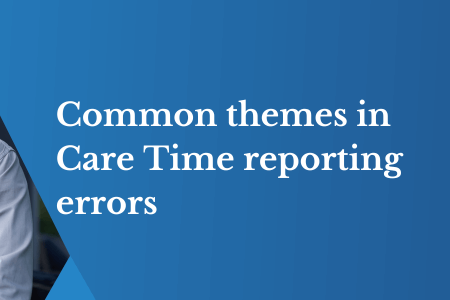6 key observations from training thousands on AN-ACC
July 7, 2023 | AN-ACC

By Aron Wong, Senior Consultant
After 12 months of facilitating the AN-ACC Essentials and AN-ACC Advanced courses it has been a privilege to meet thousands of people within aged care. After speaking with so many people and learning about their experiences I’ve observed a few things worth sharing:
1. Staff are needing to know more about other areas of aged care
There are so many topics of importance in this current era of residential aged care, and it’s important to have at least a basic understanding of many of them because of the interconnected nature of the various disciplines. Each department within aged care has a profound effect on the other areas as we all know.
A common example I have seen is the AN-ACC funding model, where one needs to understand how the model works to know when to submit a reclassification request through My Aged Care and that this also needs to be balanced with rostering considerations to ensure there are adequate staffing levels and time to achieve the mandatory care minutes in October 2023.
Amongst this the aged care industry is needing to work towards the 24/7 RN requirement in July 2023. Furthermore, the admissions team now needs to understand the impact that their admissions decisions can have on this ‘case mix’ of residents as this influences care minutes and rostering.
On top of this, the care minutes also have an impact on the Star Ratings of the facility, and the visibility of this quarter’s case mix and the care minutes delivered is crucial to understanding your next quarter’s targets.
Boards, executives, and finance teams also need to know the impact these interrelated topics have on budgeting for the financial sustainability of the organisation.
Finally, the clinical teams are also getting ready for Stronger Standards, Better Aged Care Program in the coming year and need to understand how this weaves in with everything else.
2. There is a diverse range of people interested in learning about AN-ACC
There have been an increasing number of people attending our education sessions who have had no aged care experience and are thinking to move into the industry. They are bringing fresh perspectives to the conversation but also recognise they have a steep learning curve to catch up.
Aside from this, we have seen participants from government departments and agencies, allied health professionals, acute sector staff, and people from other industries among the diverse groups that have attended our sessions. This trend seems to have been increasing over the years as more people from other sectors have joined aged care in recent years.
3. Staff retention and attraction are still widely discussed
One of the most common discussion topics in training is the difficulty aged care providers are having getting enough staff, keeping staff, and the quality of staff available. While this has been a longstanding challenge for aged care, this is of particular interest to the industry as it moves towards meeting the Mandatory Care Minute requirements in October 2023. There have even been some closures to facilities because of the lack of staff availability, or in other cases mergers with other organisations. The main question we see is how you can continue to meet requirements with a shortage of staff? There seems to be both many answers and no answers to this question and it continues to be one of the most enduring challenges in the industry.
4. People are still figuring out how to manage the care minute requirements
While some organisations and facilities have robust systems and processes in place to manage this balancing act, a larger number of facilities out there seem to still be early in the process of figuring out how to understand, report on, action, forecast and budget care and funding figures. As workforce rosters can be challenging to flex at times, some organisations are looking at managing a steady case mix with a more predictable roster, while others aim to achieve higher Star Ratings and need to exceed their care minute targets. Quite a few people appear to be trying to wrap their minds around how to manage so many levers in an already challenging environment, and this seems to be one of the main challenges we’ve seen in the industry from training thousands of people. If you need any help in any of these areas, please reach out to Mirus for help.
5. Resident assessment timeframes seem to vary widely
Thousands of staff have come through sharing their experiences on AN-ACC assessment wait times and the results seem to vary widely. It can depend on assessment loads, region, availability, etc. among other factors. The shortest assessment wait time I heard was a few hours! A provider reached out to the Department of Health and Aged Care (DoHAC) to let them know it was an end-of-life resident and the Assessment Management Organisation (AMO) was able to come out a few hours later. The longest time I have personally heard of was over two months and still waiting. The experiences seem to vary widely.
The Department does produce a dashboard on AN-ACC assessment data at their site below:
AN-ACC assessments dashboard | Australian Government Department of Health and Aged Care
6. Aged Care Resources are spread over many sites and new information becomes available regularly
I can’t tell you how many times we’ve had to update our course slides to reflect new information that has become available because new information is coming out all the time. It’s important to stay up to date so new information can be incorporated into your daily operations. As a team, we have multiple meetings throughout the week to ensure we’re always up to date with what’s happening so that we can share this with you and the industry.
Over this time, we have accumulated some resources from government sites to help you keep on top of the latest information.
Department of Health Newsletter
Residential Aged Care Funding Reform
Residential aged care funding reform | Australian Government Department of Health and Aged Care
Care Minute and 24/7 RN Guide
Aged Care Subsidies and Supplements
General Resources for My Aged Care
My Aged Care Service and Support Portal Resources
Aged Care Legislation
Aged care laws in Australia | Australian Government Department of Health and Aged Care
Aged Care Quality Standards
Aged Care Quality Standards | My Aged Care
Accreditation Reports
Find a Report | Aged Care Quality and Safety Commission
Provider Search and Star Ratings
Find a provider by name (myagedcare.gov.au)
Data for Aged Care
Home – AIHW Gen (gen-agedcaredata.gov.au)
Royal Commission
Royal Commission into Aged Care Quality and Safety
You’re welcome to reach out to share any other resources you find useful.


